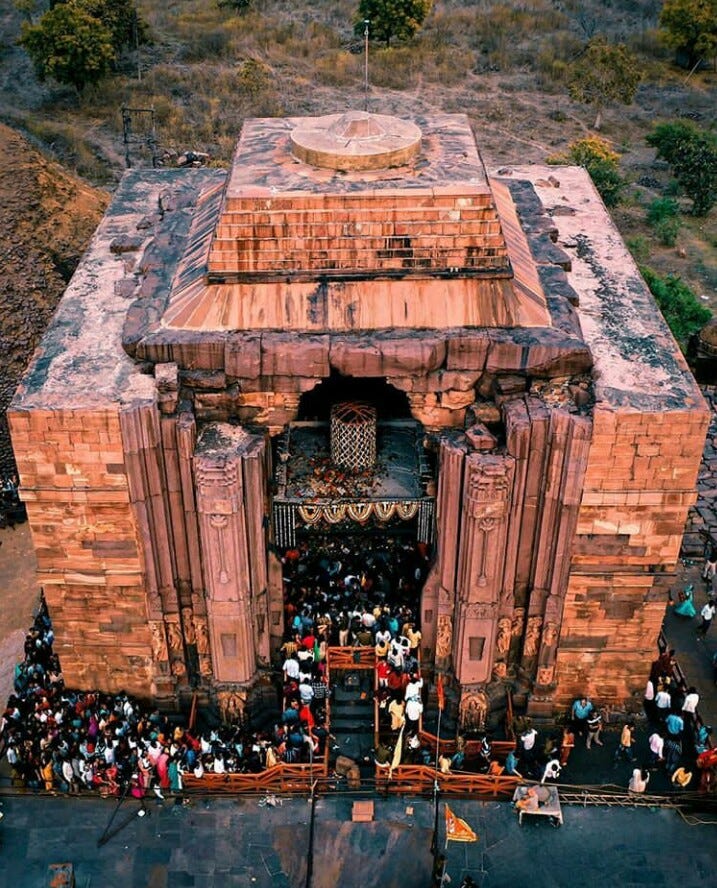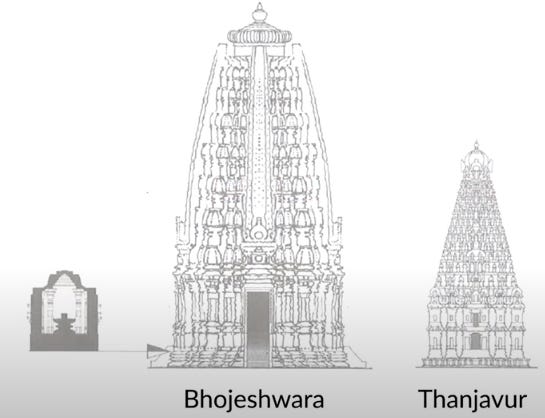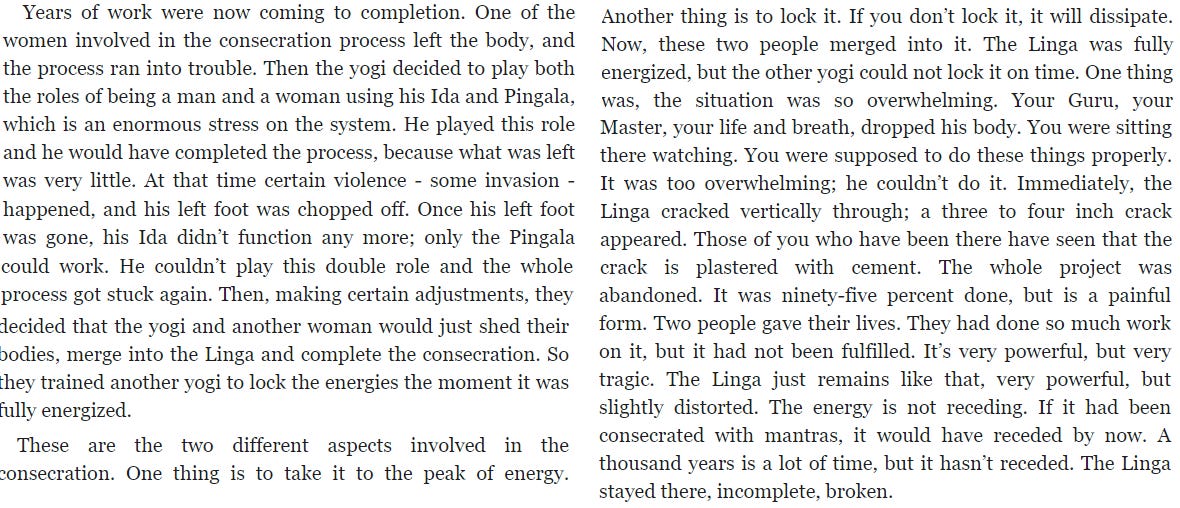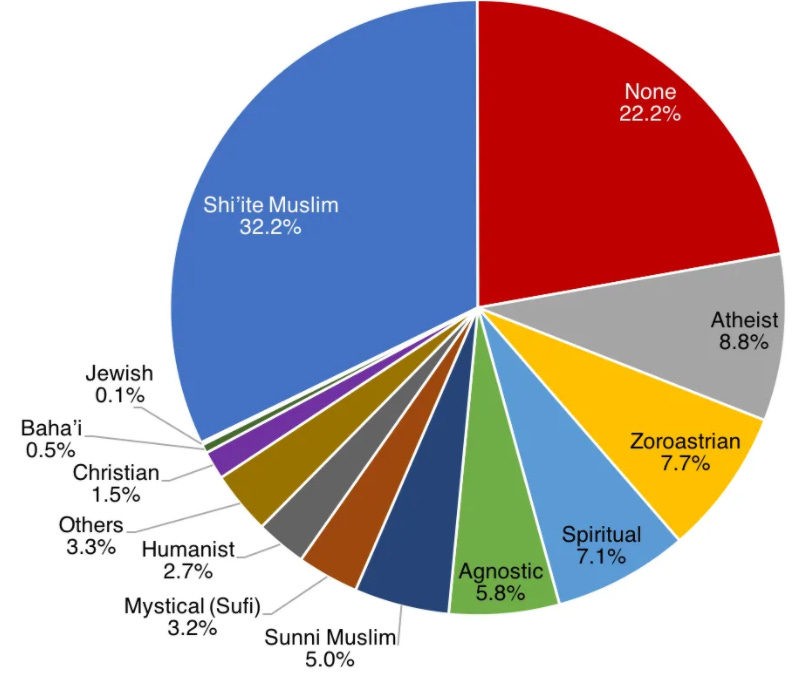Insightful newsletter of Drishtikone: Issue #204 – Quest for the Perfect Being
Perfection is not in handling a few metal coins or rearranging thoughts. But in enhancing our consciousness to its highest. This is the story how our Yogis created the perfect being - Shiva!
(Photo by Harsha Vardhan from Pexels)
“No man was ever wise by chance” ― Seneca
Perfection in life is about experiencing that which is existential. Not in rearranging a few pieces of coins or wood on this planet or another.
That is why the people who saw our lives and being in terms of energy and consciousness always understood that greatness in life came from enhancing our consciousness of every hue to its highest. Anything less is a travesty.
When the urge and dream for the most perfect being came about in the minds of our Yogis, they looked at the one who had set this whole tradition in motion. The one who epitomized, coded and disseminated it for us all - Shiva.
But how do you construct one who is so beyond you itself? By preparing many on that path and creating the necessary consciousness so it can be the raw material for the final being.
Imagine working for many lives on this and throughout this lifespan, you prepare and work hard to get there, and when you are so near, someone messes it up for you. Every investment, every plan needs to be abandoned of the greatest creation envisaged! And it lies in ruins, map on the rocks, and pieces on the sidewalk for centuries. Before someone comes along and makes it happen.
This is the story of India’s inherent consciousness at its highest. An understanding of who we are and why.
unfinished dream of Bhojeshwar Temple - the Perfect Being
This is the story of a grand attempt at creating the most perfect energy structure. Kind of like Shiva himself as an energy being. How despite a grand vision, great beings, knowledge, and abilities, something can still falter.
This is the Shiva temple - with one of the grandest Shiva Lingam anywhere in the world - the Bhojeshwar temple near Bhopal.
It was envisaged and started by Raja Bhoj who was a great king around 1010–1055. As per the plan of this temple, it was to be far larger than the temple in Thanjavur, which was built by Rajaraja Chola.
Not only was it to be so grand, but the plans were also afoot to create a lake by building dams on two rivers near the temple.
Unfortunately, this temple was left unfinished and abandoned. Some years back, when the temple was in danger of collapsing, archeologist KK Mohammad worked on its reconstruction to make it stable yet again.
The question that remains for most of us is why was such a grand temple with so much work being done was suddenly abandoned? Even when the pieces that would go into it had been created and the blueprint laid out on the ground as well.
For this one needs to understand the full scope of the work that was attempted and the enormity of that task.
In the Yogic lore, a complete being - like Shiva - with all the Chakras functioning at their peak in that body - has been the greatest dream.
This was taken up by many. Including the Theosophists, who had acquired enormous amounts of occult knowledge and the full gamut of what was needed to accomplish such a project. But it remained unproductive. They had even raised someone like Jiddu Krishnamurti to find the great “World Teacher”, who eventually abandoned the Theosophists with that landmark “Truth is a Pathless land” speech.
It was this dream that Raja Bhoj was after.
In his book “Mystic’s Musings,” Sadhguru discusses this temple and the reason why it was left abandoned in detail.
A very accomplish yogi was in charge of this project at Bhojpur. He worked on and prepared 14 people - 7 men and 7 women. The Ida and the Pingala. They were led through different types of Sadhana to bring them to a certain level of accomplishment/consciousness.
When the work was about to come to completion, one of the women left her body. The Yogi, as accomplished a being as he was, could have still completed the process but during an invasion, which most think was the reason that the temple was broken, the Yogi’s leg was cut off. Then they decided to do the unthinkable - fuse their energies into the lingam to make it work, while another Yogi was asked to lock the energies. He was so overwhelmed that he failed in his task and the lingam cracked vertically.
The lingam is still powerful but not useful. That one mistake by that Yogi caused the world of so many to go waste. And, the temple was abandoned.
This whole story shows how in the Indian civilization, spiritual work and energies were at the base of the grandeur of a temple or such structures. Structures were there to support and complete the physical aspects of the underlying work. Once the spiritual effort had fallen through, the physical work was of little use thereafter.
That is why the Bhojeshwar temple was abandoned.
The dream of a Dhyanalingam was finally accomplished in the Vellangiri mountains. And, to avoid the fiasco of Bhojpur lingam, a different stone was used.
After that one more Dhyanalinga in Bhojpur, near Bhopal, almost reached the phase of completion. However, it cracked during consecration due to a delay in the locking of energies. To safeguard against this eventuality, the linga that we consecrated is crafted from the highest (4200 units density) form of stone found in Asia." To prevent a repetition of the Bhojpur fiasco, a minute crack running vertically through the linga created by Sadhguru with a single resounding clap in a state of heightened energy. (Source)
Anyone who has been to the Dhyanalingam at the Isha Center can vouch for its power.
science of energy and its impact on physicality
If you think this discussion of consecrated energy is some hokey-pokey, then please refer to the experiments by William Tiller, the scientist at Stanford who experimented with using intention established by Buddhist Monks to change the pH value of water in the vicinity of a device “energized” by them. That is the most rudimentary level of the consecration process.
Fellow to the American Academy for the Advancement of Science, Professor Emeritus William A. Tiller, of Stanford University’s Department of Materials Science, spent 34 years in academia after 9 years as an advisory physicist with the Westinghouse Research Laboratories. (Source)
In his over 40 years of work, along with traditional science, Dr. Tiller has also worked in areas that some may term as esoteric, albeit using the normal scientific rigor! One of his research areas has been what he calls psychoenergetics. This revolves around “Intention Host devices”.
For the past 35 to 40 years, in parallel with my traditional science research and teaching at Stanford University, I have been seriously investigating the effects of human intention on both the properties of materials (inorganic and organic; non-living and living) and on what we call physical reality.
From this research, I and my colleagues have discovered that it is possible to make a significant change in the properties of a material substance by consciously holding a clear intention to do so. For example, we have repeatedly been able to change the acid/alkaline balance (pH) in a vessel of water either up or down, without adding chemicals to the water, by creating an intention to do so.
For his experiments, he has carried out experiments with highly trained Tibetan monks and found that their intentions can ‘condition’ space in a machine on an atomic level (subatomic technically). For more details, please watch his videos introducing his Intention Host Device (Video 1A, 1B, II, III).
Is Iran not an Islamic country anymore?
Gamaan is a group that studies the attitudes and beliefs within Iranian society. The normal government surveys and pronouncements are neither valid nor reasonable since they come with the threat of ‘death for apostasy’ attached. So, when a 3rd party tries to do their own surveys in a more objective way, then one needs to look at it and sit up. GAMAAN is an antonym for The Group for Analyzing and Measuring Attitudes in IRAN. As per their 2020 Survey Report, something very interesting shows up. The full English report and methodology of GAMAAN’s survey on Iranians’ Attitudes Toward Religion – 2020 can be downloaded from here.
One of the major insight from this survey is
Approximately half of the population reported losing their religion. On the other hand, 41% did not report significant changes in religious or non-religious views during their lifetime. Around 6% of the population said they had converted from one religious orientation to another. (Source)
Over half say that they have lost their original religion. Look at the chart below.
What this chart shows is that only Shi’ite (32.2%), Sunni (5.0%) and Sufi (3.2%) identify themselves as Muslims now. That comes to 40.4% of the Iranians identify themselves as Muslims now.
This essentially means that 59.6% of Iranians do not consider themselves Muslims anymore.
This is very very significant!
The signs have been visible for the last 5-6 years now.
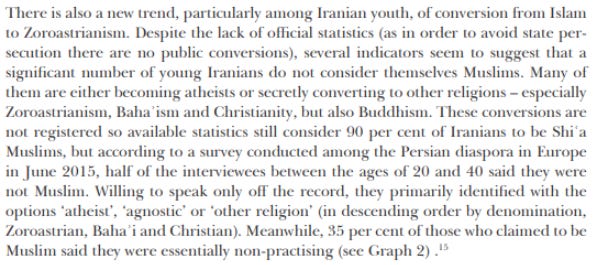
Please check our earlier newsletter on this topic where we discussed the dramatic social changes in a lot of detail - Issue #133 - The Heavens are Falling
One of the off-shoot of this radical shift in Iran is the popularity of the #FreefromHijab hashtag on Twitter.
market corner - 10 quick bytes
WhatsApp Pay goes live in India with four banks as partners - with its payments offering in India with four banks—State Bank of India, ICICI Bank, HDFC Bank, and Axis Bank / will also offer Unified Payments Interface (UPI)-based payments to its users - more
WhatsApp to roll out insurance and pension products on its platform in India soon - more
Food delivery and technology company Swiggy, is expanding its Street Food Vendors program to 125 cities. It is doing this under the Prime Minister Street Vendor’s AtmaNirbhar Nidhi (PM SVANidhi) Scheme (+podcast) - more
ICICI Securities (I-Sec), one of India’s largest brokerage house with approx. 5 million customers, has launched ‘ICICIdirect Neo’ - zero brokerage plan - will provide instant liquidity, where customers get cash within 30 minutes of selling stocks as per their chosen plan - more
Indian wealth-tech segment to be $60 billion opportunity by FY25: RedSeer report - more
Cabinet approves Rs 3,500 crore sugar export subsidy Cabinet approves Rs 3,500 crore sugar export subsidy - more
National Infrastructure Pipeline: Infra projects worth Rs 44 lakh crore under implementation and Rs 22 lakh crore projects in the development stage - more
Covid wiped out 81 mn jobs in Asia-Pacific; women, youngsters affected: ILO - more
PM Modi’s Startup India: Govt-recognised startups jump 60% in 12 months - more
India to set up a national security panel on trusted telecom sources, devices - the committee will declare a list of trusted sources and products for telecom service providers - more
nota bene
Grooming Jihad: Supreme Court on Wednesday dismissed a plea seeking to set aside an Allahabad High Court order, which held that conversions just for the sake of marriage are invalid. A Bench headed by Chief Justice of India SA Bobde while dismissing the plea said, “We see no reason to interfere (with Allahabad High Court order), dismiss.” (Source)
4G auctioned: Telecom and IT minister Ravi Shankar Prasad said that the government will auction a total of 2251.25 MHz spectrum in 700MHz, 800MHz, 900MHz, 1800MHz, 2100MHz, 2300 MHz, and 2500 MHz bands. 2251.25 MHz will be offered with a total valuation of Rs. 3,92,332.70 crore (at reserve price). (Source)
Indigenous carbine: A new joint venture protective carbine (JVPC) has successfully passed the final phase of user trials, meeting all criteria of the General Service Qualitative Requirement, the Ordnance Factory Board (OFB) has announced. The compact gas-operated weapon has an effective range of more than 100 meters and weighs less than three kilos. During the tests, the ammunition penetrated 3.5 mm thick mild steel plate and 23 layers of soft armor at 100 meters, the OFB said in a statement (Source)
Amazon Pollution: A van load of Amazon plastic packaging is dumped in oceans every 70 minutes and that includes enough air pillows to wrap around the Earth 500 times, a study reveals. Marine conservation charity Oceana published a new report investigating the amount of waste the retail giant and its sellers generate each year around the world. They found Amazon has a 'disturbingly large' plastic waste footprint, including 211,000 tonnes of plastic packaging for the seven billion items sold worldwide. (Source)
Vaccine as a Tool: China plans to use the possible COVID-19 vaccine as a political tool, China's vaccine diplomacy reveals. China is attempting to politicize the COVID-19 vaccine and to not only change the preceding narrative in its favor but also serve Chinese interests. It is promising early access to the vaccine to poor and developing countries across Asia, Africa, Latin America, and other areas of the world. (Source)
Mutant COVID: A new genetic variant of SARS-CoV-2, the virus that causes COVID-19, has emerged in the United Kingdom, but it's unlikely to threaten the effectiveness of COVID-19 vaccines, scientists say. Now, researchers in the U.K. have identified a new variant that has caused infections in nearly 60 local authority areas, Health Secretary Matt Hancock said Dec. 14 while addressing the House of Commons (Source)
the dark side of Christmas
The holiday season in December has the greatest impact on the environment globally. Let us understand how.
While returns are as high as 25% for Amazon around the year, and 9% for in-store shopping; the returns for the Christmas season are far higher!
Nearly half (45%) of holiday shoppers will return unwanted items between Dec. 26-31, according to reverse-logistics firm Optoro, with by far the most (91%) of returns happening in stores. (Source)
The first week of January is known as the “National Returns Day” within UPS. The company expected to deliver a record 5.8 million returns packages to retailers during the first week of January. 1.3 million returns on Jan. 5 alone!
This is the, as Forbes says - the “Dark Side of Christmas”. A time when mindless shopping takes over everywhere.
Today’s ONLINE PAPER
Check out today’s “The Drishtikone Daily” edition.
Support Drishtikone
If you consider our work important and enriching and would like to contribute to our expenses, please click on the button below to go to the page to send in your contribution. You can select the currency (for example, INR or USD, etc) and the amount you would like to contribute.
If you like this post - please share it with someone who will appreciate the information shared in this edition
If you like our newsletter, please share it with your friends and family





